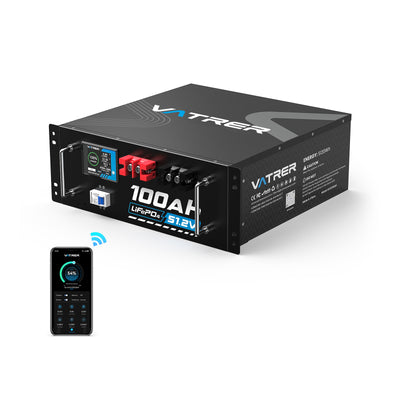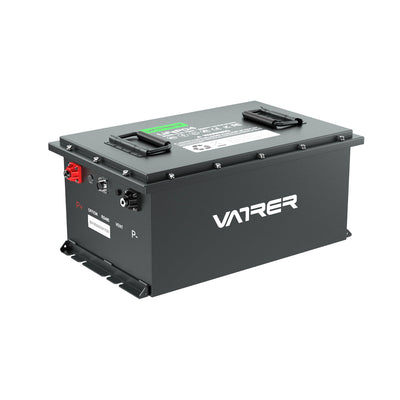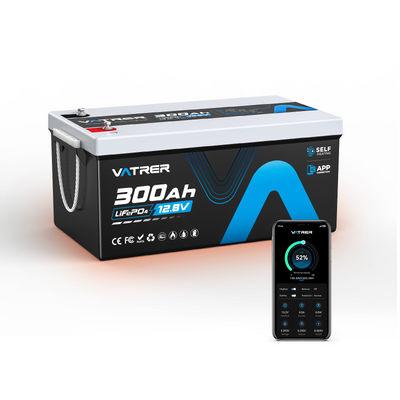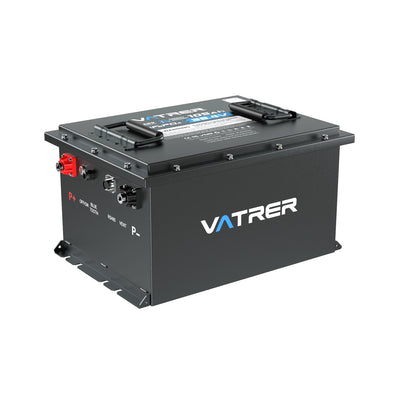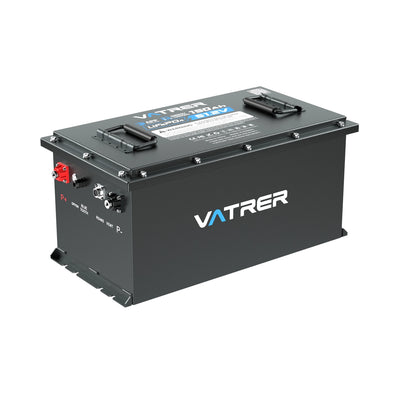
Why You Should Upgrade Your Golf Cart to Lithium Battery
If you own an electric golf cart, chances are you’ve heard about the growing popularity of lithium golf cart batteries. Many owners are replacing traditional lead-acid batteries with lithium systems to gain faster charging, longer battery life, and stronger performance. But is it really worth it? This guide breaks down the reasons behind the golf cart battery upgrade, showing how a lithium system can improve power, efficiency, and ownership experience, and what to consider before making the switch.

What Makes Lithium Different
The key difference between lithium and lead-acid lies in the chemistry. Most lithium golf cart batteries use Lithium Iron Phosphate (LiFePO4), while traditional lead-acid batteries rely on lead dioxide and sulfuric acid. This fundamental shift changes everything, from safety and weight to how much energy you can store and how often you need to maintain the battery.
The following is a comparison between lithium batteries and traditional lead-acid batteries:
| Feature | Lithium (LiFePO4) | Lead-Acid |
|---|---|---|
| Composition | Non-toxic, no lead or acid leakage | Contains lead and acid, risk of corrosion |
| Energy density | Higher, more energy in less space | Lower, heavier and bulkier |
| Management | Built-in BMS for automatic protection | Manual maintenance and balancing |
| Efficiency | ≥95% energy transfer | Around 80–85%, higher energy loss |
In practical terms, LiFePO4 chemistry plus an onboard Battery Management System (BMS) keeps voltage and temperature in safe ranges, reduces corrosion, and simplifies maintenance. From the start, the upgrade means fewer hassles and a cleaner, safer system.
Cycle Ratings & Real-World Longevity for a Golf Cart Battery Upgrade
A major reason for a lithium battery upgrade is lifespan. On average, high-quality lithium batteries last 4,000 or more cycles, while most lead-acid batteries manage only 300-1,000 under typical use. This difference can mean several additional years of service life.
However, cycle life depends on several conditions: depth of discharge (DoD), charging behavior, and temperature. The deeper you discharge a battery each cycle, the faster it ages.
| Depth of Discharge | Relative Cycle Life Trend |
|---|---|
| 50% DoD | Longest cycle life |
| 80% DoD | Standard industry rating (≈4,000 cycles for quality lithium) |
| 100% DoD | Shorter lifespan |
This durability means fewer replacements, less downtime, and lower long-term costs, real long-term benefits that outweigh the higher initial purchase price.
How Lithium Boosts Golf Cart Performance: Higher Power & Lighter Weight
A lithium golf cart battery doesn't just last longer, it performs better. Lithium cells deliver stronger voltage consistency throughout discharge, which means steadier power even as the battery runs low.
Because lithium batteries are far lighter, often about half the weight of an equivalent lead-acid setup, the cart accelerates faster, climbs hills more easily, and handles better overall. For example, a 48V 105Ah lithium battery weighs around 102 lbs, while a comparable lead-acid set can weigh up to 200 lbs. That weight reduction alone improves golf cart performance and reduces strain on tires, suspension, and brakes.
You'll also notice less voltage drop during heavy loads, meaning better hill climbing and a higher top speed potential. This is where the superior performance of lithium becomes most obvious.
Golf Cart Upgraded with Lithium: Faster Charging Time & Better Efficiency
Nobody wants to wait overnight to charge their cart. Upgrading to lithium means shorter charge cycles and better energy use. Lithium batteries can recharge to full in roughly 4-6 hours, compared to 8-10 hours for lead-acid systems.
A quick estimate for charging time is:
Charge time ≈ (Battery Ah ÷ Charger Amps)
So a 48V 105Ah battery with a 20A charger takes about five hours, depending on taper and temperature. Some lithium systems also support opportunity charging, meaning you can safely top up anytime without harming the cells, something you can't do with lead-acid batteries.
| Metric | Lithium Upgrade | Lead-Acid |
|---|---|---|
| Typical full charge time | 4–6 hours | 8–10+ hours |
| Energy efficiency | ≥95% | 80–85% |
| Opportunity charging | Supported | Not recommended |
Faster charging and higher efficiency mean less downtime and more time on the move, especially important for fleets, communities, or resort operators.
Note: "Opportunity charging" refers to partially charging the battery during short breaks before it is fully discharged. For example, during a lunch break or a 30-minute stop, you can plug in the charger to give it a short boost without waiting for the battery to be completely discharged. For lithium batteries, this "charge whenever you need to" approach will not damage battery life; however, for traditional lead-acid batteries, frequent shallow charging can lead to sulfation and shorten their lifespan.
Golf Cart Battery Maintenance Made Simple: BMS, Daily Care, and Smart Monitoring
Lead-acid batteries need regular watering, equalizing, and corrosion checks, time-consuming and messy tasks. A lithium battery upgrade simplifies ownership dramatically.
Modern systems include a BMS (Battery Management System) that automatically balances cells and prevents overcharge, over-discharge, and overheating. Some advanced kits, like those from Vatrer Battery, add LCD screens or Bluetooth App monitoring for real-time tracking of voltage, temperature, and charge level.
Here's what good lithium care looks like:
- Store at 40-60% charge if unused for weeks.
- Keep terminals dry and secure, no water refills needed.
- Always use the proper lithium-compatible charger (not a lead-acid one).
This minimal upkeep makes lithium ideal for users who want more driving and less tinkering.
Golf Cart Battery Safety Standards and Reliability
When switching power systems, safety is non-negotiable. High-quality lithium golf cart batteries come with multiple protection layers built into the BMS, preventing short circuits, temperature extremes, and electrical faults.
Reputable brands, such as Vatrer Battery, test each battery under strict international standards like UN38.3 and IEC/UL protocols. Many models feature low-temperature charge protection (automatically pausing charging below 32°F) and discharge protection (down to −4°F), ensuring reliable performance across seasons.
Unlike lead-acid batteries, lithium systems contain no free acid, reducing corrosion, leaks, and gas emissions. That makes them not only safer for users but also for storage and transport.
Upgrade Golf Cart Lithium Battery: Cleaner Operation
A lithium battery upgrade for golf cart also improves environmental performance. There's no acid or lead leakage risk, and the batteries generate no direct emissions. Paired with the naturally quiet operation of electric golf carts, this means cleaner air and a quieter neighborhood.
It's true that neither lithium nor lead-acid is perfectly green, lithium mining has environmental costs, and lead is hazardous. However, the longer lifespan and higher efficiency of lithium batteries mean less frequent replacements and less overall waste.
Always dispose or recycle batteries through certified facilities. Lead-acid has a mature recycling network, and lithium recovery systems are improving quickly worldwide.
Why a Lithium Golf Cart Battery Upgrade Pays Off
While lithium batteries cost more upfront, their long lifespan and low upkeep make them a smart investment.
To understand why, consider this simplified framework:
TCO = Purchase Cost + (Energy Cost × Usage) + Maintenance – Residual Value
Lithium batteries reduce both energy cost (due to higher efficiency) and maintenance cost, while also extending the replacement cycle. For fleets or heavy-use owners, that can mean thousands saved over the life of the vehicle.
In short, the long-term benefits go beyond convenience, they directly affect your wallet.
Golf Cart Lithium Battery Conversion Checklist
Before starting your golf cart battery conversion, check these important details:
- Voltage Compatibility: Match your cart's system (36V, 48V, 72V) before installation.
- Charger Profile: Ensure you're using a CC/CV lithium charger tuned to the correct voltage.
- Mounting Fit: Verify dimensions and ventilation inside the battery compartment.
- Controller & Wiring: Older systems may need upgraded solenoids or controllers to handle higher current.
- Warranty & Support: Confirm cycle or year coverage, and understand how BMS-related cutoffs are handled by the battery manufacturer.
Once these boxes are ticked, your golf cart lithium battery upgrade becomes a straightforward step toward better performance with fewer maintenance worries.
Conclusion: Upgrading to Lithium for Long-Term Benefits
Upgrading your golf cart to lithium isn't just a technical change, it's a lifestyle upgrade. You'll experience stronger acceleration, shorter charging time, longer battery life, and much less maintenance, all while reducing your environmental footprint.
If you're ready to make the change, choose a battery built for reliability and real-world performance. Vatrer Battery offers advanced lithium golf cart batteries with over 4,000 cycles, integrated 200A BMS, low-temperature protection, and user-friendly LCD/App monitoring. These systems combine safety, power, and convenience for years of confident use.
When you upgrade to lithium, you're not just replacing a battery, you're future-proofing your golf cart for smarter, cleaner, and more efficient mobility.
FAQs
How Do i Size a Lithium Golf Cart Battery For My Range And Terrain?
Start with energy, not just amp-hours: usable energy (Wh) ≈ system voltage (V) × capacity (Ah). Light use on flat ground often falls in the 20–30Wh per mile range per passenger, while hilly routes, frequent stops, or heavy payloads can push beyond 40–60Wh per mile.
Estimate your typical miles per day, multiply by your Wh-per-mile, and add a 20–30% buffer for headwinds, hills, and cold weather. For example, a 48V 105Ah battery stores ~5,040Wh, if your real-world usage is ~40 Wh/mile, expect roughly 120–150 minutes of mixed driving or ~100–120 minutes with frequent hills, depending on speed and load. Prioritize a battery that meets peak current needs (hill starts, inclines) as much as capacity; continuous discharge ratings and BMS limits matter for golf cart performance.
Do i Need a New Charger For a Lithium Battery Upgrade?
Yes, in most cases. Lithium packs require a CC/CV (constant current/constant voltage) profile matched to the pack voltage and manufacturer’s recommended cutoff. A legacy lead-acid charger may overcharge, undercharge, or run equalization routines that aren’t suitable for lithium. Choose a charger with the correct voltage, appropriate current (to hit your desired charging time), temperature safeguards, and ideally communication or settings approved by the battery brand. This protects battery life and ensures you actually experience the “faster charging” advantage.
Will a Lithium Golf Cart Battery Upgrade Affect My Cart’s Warranty or Insurance?
It can. Check your cart manufacturer’s policy and warranty language before conversion. Some OEMs specify approved battery chemistries or third-party kits, others require professional installation to maintain coverage. Document your golf cart battery conversion (photos, wiring diagram, torque notes), retain receipts, and follow the battery maker’s installation and operating instructions. If your cart is under financing, lease, or fleet insurance, confirm that the upgrade is disclosed and compliant to avoid surprises.
How Does Hot Or Cold Weather Affect Lithium Battery Performance And Storage?
All batteries are temperature-sensitive. Lithium performs well in typical ambient ranges, but most packs implement low-temperature charge protection to prevent charging below freezing. In winter, store the cart in a sheltered area and charge after the pack returns above the cut-off temperature; in summer, avoid prolonged heat soak in enclosed sheds. For seasonal storage, leave the pack at ~40–60% state of charge, disconnect parasitic loads, and check it every 2–3 months. These practices protect battery performance and maximize long term benefits.
Can i Mix Lithium And Lead-Acid Batteries or Keep Some Old Lead-Acid Accessories?
Do not mix chemistries in the same series or parallel string. Lithium and lead-acid have different voltage curves, internal resistance, and charge profiles, which lead to imbalance, accelerated wear, and potential safety risks. Replace the full set with a properly sized lithium battery and ensure the charger matches lithium. Accessories like voltage reducers, fuses, and contactors can often remain if they meet the new voltage/current requirements, verify ratings, and replace undersized components during the golf cart battery upgrade.
What Installation Details Are Most Often Overlooked During a Conversion?
Beyond voltage matching, three details cause most issues: proper fusing, correct cable gauge/length, and secure mounting. Install a main fuse sized for the pack’s maximum continuous current; use appropriately rated cables with clean lugs torqued to spec; and mount the pack with protection against vibration and moisture ingress per the manufacturer’s guidance. Calibrate or replace the state-of-charge gauge so it reads lithium’s flat voltage curve accurately, and confirm your controller/solenoid can handle the pack’s current for reliable superior performance.
How Do i Calculate The Real ROI of Upgrading To Lithium?
Avoid focusing only on upfront price. Build a simple TCO model: purchase cost + (electricity cost × kWh used) + maintenance/time cost − residual value over a fixed period (e.g., 5–8 years). Lithium’s higher round-trip efficiency lowers electricity spend; its minimal battery maintenance saves time and shop supplies; and longer cycle life usually avoids a mid-life replacement that lead-acid often requires. Fleets, campuses, resorts, and high-utilization owners typically see the fastest payback because reduced downtime and faster charging translate directly into more operational hours.
What Should i Do With My Old Lead-Acid battery After a Lithium Battery Upgrade?
Never landfill lead-acid batteries. Use certified recycling channels, many auto parts stores, scrap dealers, or municipal sites accept them and may offer a core credit. Keep the cases upright, avoid tipping, and transport them in a ventilated vehicle area. Recycling lead-acid protects the environment and is usually straightforward thanks to mature collection systems. Ask your installer or the lithium supplier for a recommended recycler to close the loop on the environmental impact side of your golf cart battery upgrade.
Share











































































